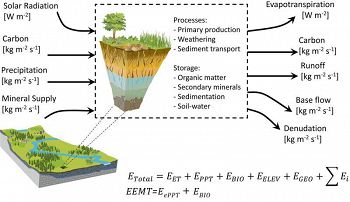Rasmussen et al., 2015
Quantifying Topographic and Vegetation Effects on the Transfer of Energy and Mass to the Critical Zone
Rasmussen C., Pelletier J.D., Troch P.A., Swetnam T.L., and Chorover J. (2015)
Vadose Zone Journal 14 (11)
-
Catalina-Jemez, INVESTIGATOR
-
Catalina-Jemez, INVESTIGATOR
-
Catalina-Jemez, INVESTIGATOR
-
Catalina-Jemez, INVESTIGATOR
-
Catalina-Jemez, INVESTIGATOR
Abstract
Conceptual framework characterizing major fluxes and processes in the critical zone. The fluxes may be quantified in terms of energy and mass balance terms, with the total energy transferred to the critical zone (ETotal) the sum of energy associated with evapotranspiration (EET), precipitation (EPPT), net primary production (EBIO), erosion and sediment transport (EELEV), geochemical gradients (EGEO), and any other energy and mass transfers Ei) Effective energy and mass transfer (EEMT) is equal to the net energy and mass fluxes associated with effective precipitation (EePPT) and net primary production (EBIO.
Critical zone evolution, structure, and function are driven by energy and mass fluxes into and through the terrestrial subsurface. We have developed an approach to quantifying the effective energy and mass transfer (EEMT, MJ m−2 yr−1) to the subsurface that accounts for local variations in topography, water and energy balances, and primary production. Our objectives were to quantify how (i) local topography controls coupled energy and water transfer to the subsurface, and (ii) vegetation effects on local-scale evapotranspiration and primary production controls of energy and mass transfer to the critical zone, both at the pedon- to hillslope-scale resolution, in the context of quantifying controls on EEMT. The model was tested across a semiarid environmental gradient in southern Arizona, spanning desert scrub to mixed conifer ecosystems. Data indicated clear variations in EEMT by topography, via both aspect and local water redistribution, and with current vegetative cover. Key findings include: (i) greater values of EEMT on north-facing slopes in a given elevation zone, with a north-facing aspect equivalent to an ~300-m elevation gain; (ii) a power law relationship between aboveground biomass and EEMT, with disturbance in the form of stand-replacing wildfire substantially reducing estimates of EEMT; and (iii) improved correlation of EEMT to pedon-scale variations in critical zone structure with EEMT values that include topography. Incorporating greater levels of environmental variation and complexity presents an improved approach to estimating the transfer of energy and mass to the subsurface, which is important to our understanding of critical zone structure and function.
Citation
Rasmussen C., Pelletier J.D., Troch P.A., Swetnam T.L., and Chorover J. (2015): Quantifying Topographic and Vegetation Effects on the Transfer of Energy and Mass to the Critical Zone. Vadose Zone Journal 14 (11). DOI: 10.2136/vzj2014.07.0102
 This Paper/Book acknowledges NSF CZO grant support.
This Paper/Book acknowledges NSF CZO grant support.
Associated Data
Jemez River Basin - GIS/Map Data - EEMT-topo (2010-2011)
1 components •
Jemez River Basin •
Biology / Ecology, Climatology / Meteorology, GIS / Remote Sensing, Hydrology •
Durcik, Matej; Rasmussen, Craig
Explore Further






